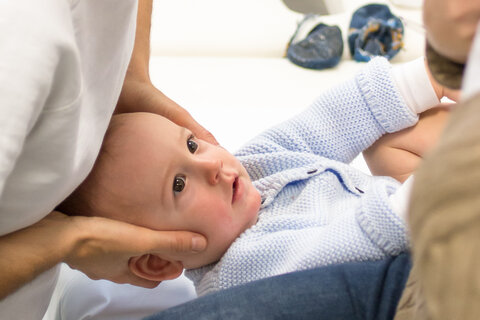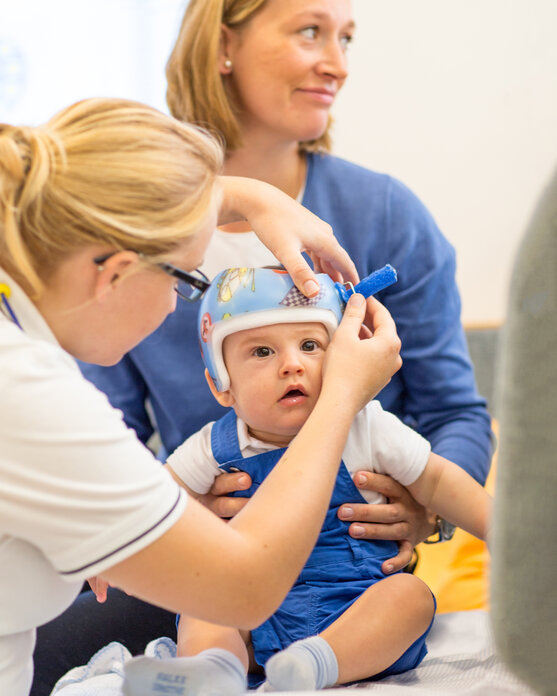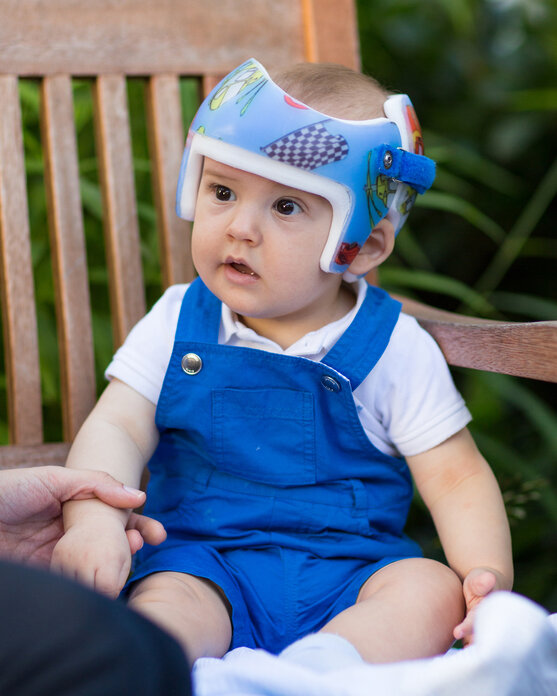A cranial helmet is an orthosis that gently guides the head into the most anatomical and aesthetic shape possible.
Get to know us and learn more about our core competencies!
Make an appointment over the phone or send us a message!

Born with a crooked head
Our experience with the helmet
Immediately after Anton’s birth, the doctors noticed deformations in his skull. His parents opted for helmet therapy to guide his head into a symmetrical shape. Anton wore a helmet for seven months. It was not always easy for the infant and his environment, but today – four years later – it’s clear that it was worth the effort.
Anton’s mother talks about her experiences with the head orthosis and explains why, at one point, the whole family went through the city wearing a helmet.
Anton’s head deformity was developed in the womb. He turned around in my belly extremely early on and was a big child. From the very beginning, his head did not have the space in my pelvis that he would have needed to form himself symmetrically. Shortly after his birth, it was clear that one half of the face was more pronounced than the other, and one side also appeared somewhat flatter behind the ears.

Back then, we were advised to position Anton’s head in such a way that only one side is under any load. I tried to support his head with rolled up cloths. Unfortunately, we did not take the problem very seriously at the beginning. Only six weeks after the birth did I learn from a physiotherapist that there are special positioning cushions that would have been necessary in Anton’s case.
Unfortunately the deformation of his head had progressed so rapidly in the meantime that I got the feeling that the situation is getting out of hand. Anton’s head deformity became worse by the week. Because physiotherapy was not very effective in our eyes, my husband and I visited a specialist in pediatric orthopedics and osteopathy. When Dr. Umari informed us about helmet therapy, the decision was made relatively quickly. We really wanted to take advantage of the six months that we had left to get his head into shape. That’s why Anton received his helmet at the early age of three months. This gave him an extraordinarily early start, which turned out to be a good decision afterwards. Nevertheless, we knew from the beginning that his head would never become completely symmetrical – the deformation had simply progressed too far.
How did the helmet treatment work at Pohlig?
From the very beginning, we felt very well cared for at Pohlig. I was impressed by the professionalism of the employees. The team was incredibly friendly and as a parent, you felt listened to and understood regarding your fears and worries. Of course, fitting the helmet is also stressful for infants. But the whole atmosphere at Pohlig was very pleasant. I even remember waiting in the fitting rooms was a pleasant experience. I had a great time talking to other parents while our children played with each other.
To make an individualized orthosis for Anton, his head was scanned first. When the helmet was finished, we had to drive regularly to Traunstein to check how much had changed. As a rule, the appointments last about three hours. In Anton’s case, the problem was that the head was so crooked that he got some pressure marks, which naturally led to pain. There were times when we were in Traunstein almost every week. Eventually, a completely new helmet was made for him after six months. That was the breakthrough.


Did you take any other therapeutic options during the treatment with the helmet?
Yes, we have continued to have Anton treated osteopathically. Dr. Umari practices at Pohlig in Traunstein a few days a week, which was very pleasant for us because she was able to treat Anton osteopathically during the waiting times. I discontinued physiotherapy at the time because I felt that I was better off with Pohlig and the orthosis and with all the experts.
How did Anton react to the helmet?
Interestingly enough, Anton’s helmet wasn't a problem at all at the beginning. Because he was relatively young, he probably didn't notice the helmet at all. It was only at six to seven months that a phase began in which Anton no longer wanted to wear the helmet. Our son gradually got a better feel for his body – and then the helmet became a problem. I am still convinced that helmet therapy can do a lot and I am very happy that we chose it, but nonetheless, a helmet is not an easy path for parents and children.
What I have definitely noticed is that the whole family has to be totally accepting of the helmet. The most important thing is that you agree as a couple. My husband and I decided, for example, that Anton would not have to wear the helmet at night, because in our opinion he was simply too young for it. Of course, there are doctors who insist that the helmet is taken off only one hour a day – but we wouldn't have been able to do that. For me as a mother, there were days when it just wasn't possible. Sure, this is not particularly conducive to therapeutic success, but it was usually days when Anton teethed and the previous night was very short...you have to find the best solution for the situation. But I only learned this over time. The stroller was perfect, for example. Anton wore the helmet a lot when we were out and about. He often even forgot about his helmet during all the distractions.

Yes, I actually did! At Pohlig, I was shown exactly how I had to put on my son’s helmet. I was advised to wait for a happy, relaxed moment and then very deliberately put on Anton’s helmet. My personal trick was to put the helmet on Anton in his highchair when he had something delicious to eat in his hand. I put on the helmet and immediately clapped my hands – or did something else to distract him. But of course it wasn't always possible to put on the helmet without him crying.
Many people were initially irritated, even in our close circle of acquaintances. When we were on the road, most thought my child had epilepsy. The nice thing was that the helmet was so well received in our family that Anton’s older brother also didn't want to leave the house without a helmet. He then put on his bicycle helmet and, out of solidarity, I also wore my helmet. And so we took a walk through the city – one with an orthosis and two with bicycle helmets. Probably everyone thought: My goodness, that poor family!

Anton is now four years old. Was helmet therapy successful?
Yes, it was! We completed the therapy when Anton was one year old. So he wore his orthosis for a total of seven months. Of course, it would not have been possible to say what it would have been like if he had actually left the helmet on 23 hours a day. However, the main objectives were achieved: Anton’s jaw is straight and the displacement of the ears could be corrected as well as possible. Looking at Anton’s head from above, you can still see that his ears are slightly offset, but this is hardly noticeable in the general appearance. In retrospect, we are very happy that we went through with the helmet therapy. It wasn't an easy journey, but it was the right one.
Anton has developed beautifully. He is one of the largest in his kindergarten group and is a happy, very athletic boy. We still talk a lot about his helmet today and remember it fondly. As I said, it’s a hard job for parents, but if everyone in the family is behind it, it works.
In retrospect I would recommend not letting so much time go by. I am still annoyed that I spent so long in physiotherapy. It would certainly have been better to get in touch with a specialist right away. Back then, I definitely underestimated how quickly a baby’s head can deform.

Let yourself be inspired! We follow many interesting patients during their Pohlig appointment and give you personal insights.

For those who want to delve even deeper into the subject, we have a suitable video for almost every area of treatment!

Take a look behind the scenes at Pohlig and learn about different health conditions and our innovative assistive technology solutions!

Sometimes funny, sometimes explanatory, sometimes emotional - but above all always entertaining: our videos on TikTok!

